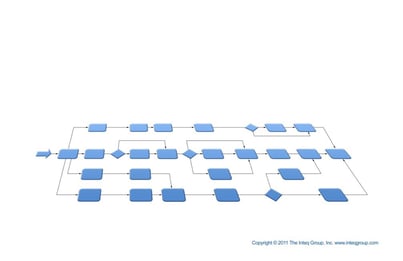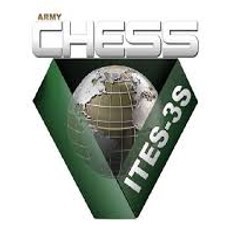Organizations are complicated, complex and chaotic. Transformational BPR requires engaging the business from 360° - analyzing the people / roles, processes and technology at the tactical, operational and strategic layers – and analyzing how the people / roles, processes and technology engage one another across and between each layer. This post discusses the tactical layer. The operational and strategic layers are discussed in separate posts.
The Tactical Layer
The tactical layer of an organization is the foundational layer. Its where the “rubber meets the road” so to speak. The tactical layer includes the business work activities, the hands-on staff performing the work activities, and the workflows and supporting policies, procedures and technology. Together, these elements comprise business processes.
Business process maps and supporting diagrams are core tools for defining and analyzing the tactical layer of an organization.
For the purpose of this discussion, the tactical layer of an organization is represented by the high-level illustration of a process map below.
The blue rectangles represent work activities and the arrows represent the flow / sequence of work activities.
Business processes span the enterprise at the tactical layer. The business processes at the tactical layer drive value creation in an organization via the production of the organization’s outputs – products in the form of goods and services for customers.
The tactical layer of an organization and its associated business processes comprise a complicated system. There are many interrelated moving parts - work activities, policies, procedures and technologies comprising and supporting the work activities and staff performing the work activities.
A traditional mechanical watch, such as a fine Swiss watch, is a good example of a complicated system. A mechanical watch has many moving parts – gears, springs, levers - that form a sophisticated mechanism to continually track and present the flow of time. The gears, springs and levers work together mechanically – a particular gear turns another gear which in turns rotates a dial.
A watch mechanism, regardless of the number of interrelated moving parts, is not a complex mechanism because all of the moving parts move together mechanically.
Complexity manifests when the moving parts of a system interact with each other dynamically – involving competitive, conflicting and subjective interactions among the parts. The interactions among the moving parts are based on reasons other than rule based mechanical movement.
In other words, the gears in a mechanical watch do not negotiate with each other regarding when and how they move. The gearing is complicated, but it moves mechanically.
In other words, the gears in a mechanical watch do not negotiate with each other regarding when and how they move. The gearing is complicated, but it moves mechanically.
Similarly, business processes at the tactical layer of an organization are complicated – like the gearing of a mechanical watch. This tactical layer of an organization are where mechanical rules are applied - policies, procedures, workflow and supporting technology. Complexity, however, also enters the tactical layer via the interactions among staff performing the work activities.
There is significant opportunity for transformation at the tactical layer of an organization. Well engineered business processes at the tactical layer maximize the effectiveness and efficiency of the complicated mechanical components of the work activities and the complex interactions among the staff performing the work activities.
The Next Step
Every organization continually experiences major changes and shifts in their business environment and almost every organization is currently experiencing at least one of the 10 reasons - and typically multiple reasons for transformational BPR.
A business platform that is high-performing, scalable, extensible, adaptable/nimble, robust and transparent enables your organization to successfully manage and leverage the chaos of continual shifts and changes in your business environment.
However, your business platform is complicated, complex and chaotic. Transformation is equally complicated, complex and chaotic. Successful transformation requires substantial business knowledge, adept judgment and seasoned experience.
When you are ready for transformational BPR the next step is very simple – contacts us and let’s discuss your organization and BPR requirements in more detail. We can assist your organization in creating the future-state blueprint of your business platform and in transforming the blueprint into reality.
Today’s rapidly changing business environment favors high-performing, agile organizations capable of delivering extraordinary customer and business value.
Meeting this challenge often requires transformative change - and sustainable on-going improvement in business processes, organizational culture and supporting technologies.
Subscribe to my blog | Visit our Knowledge Hub
Visit my YouTube channel | Connect with me on LinkedIn
Check out our Business Analysis Training Courses and Consulting Services




















